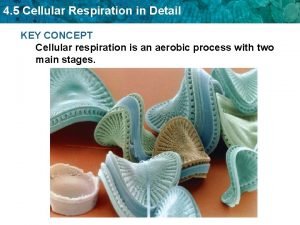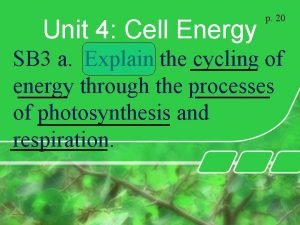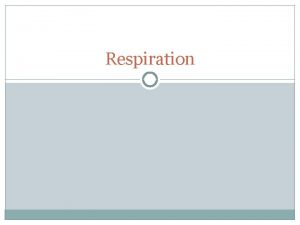4 5 Cellular Respiration in Detail KEY CONCEPT








- Slides: 8

4. 5 Cellular Respiration in Detail KEY CONCEPT Cellular respiration is an aerobic process with two main stages.

4. 5 Cellular Respiration in Detail Glycolysis is needed for cellular respiration. • The products of glycolysis enter cellular respiration when oxygen is available. – two ATP molecules are used to split glucose – four ATP molecules are produced, net gain of 2 ATP – two molecules of NADH produced – two molecules of pyruvate produced

4. 5 Cellular Respiration in Detail The Krebs cycle is the first main part of cellular respiration. • Pyruvate is broken down before the Krebs cycle. – carbon dioxide released – NADH produced – coenzyme A (Co. A) bonds to two-carbon molecule and enters the Krebs Cycle - Citric Acid (6 -C) is formed.

4. 5 Cellular Respiration in Detail CO 2 released.

4. 5 Cellular Respiration in Detail • The Krebs cycle produces energy-carrying molecules. – NADH and FADH 2 are made – intermediate molecule with Co. A enters Krebs cycle – citric acid (six-carbon molecule) is formed – citric acid is broken down, carbon dioxide is released, and NADH is made – five-carbon molecule is broken down, carbon dioxide is released, NADH and ATP are made – four-carbon molecule is rearranged, and NADH and FADH 2 molecules are made.

4. 5 Cellular Respiration in Detail The electron transport chain is the second main part of cellular respiration. • The electron transport chain uses NADH and FADH 2 to make ATP. – high-energy electrons enter electron transport chain – energy is used to transport hydrogen ions across the inner membrane – 2 H+ and ½ O = H 20

4. 5 Cellular Respiration in Detail The electron transport chain is the second main part of cellular respiration. • The electron transport chain uses NADH and FADH 2 to make ATP. • The breakdown of one glucose molecule produces up to 38 molecules of ATP. – Hydrogen ions flow through a channel in the membrane – ATP synthase produces ATP

4. 5 Cellular Respiration in Detail • 4. Oxygen picks up electrons from the ETC (electron transport chain) and hydrogen ions to make water. • No oxygen= No energy = cell death • http: //www. mhhe. com/biosci/bio_animations/MH 01_Cellul ar. Respiration_Web/















